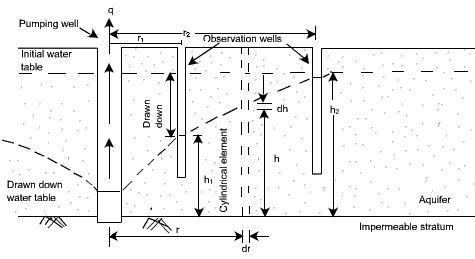Field or in-situ measurement of permeability avoids the difficulties involved in obtaining and setting up undisturbed samples in a permeameter. It also provides information about bulk permeability, rather than merely the permeability of a small sample.
A field permeability test consists of pumping out water from a main well and observing the resulting drawdown surface of the original horizontal water table from at least two observation wells. When a steady state of flow is reached, the flow quantity and the levels in the observation wells are noted.
Two important field tests for determining permeability are: Unconfined flow pumping test, and confined flow pumping test.
Unconfined Flow Pumping Test

In this test, the pumping causes a drawdown in an unconfined (i.e. open surface) soil stratum, and generates a radial flow of water towards the pumping well. The steady-state heads h1 and h2 in observation wells at radii r1 and r2 are monitored till the flow rate q becomes steady.
The rate of radial flow through any cylindrical surface around the pumping well is equal to the amount of water pumped out. Consider such a surface having radius r, thickness dr and height h. The hydraulic gradient is
![]()
Area of flow, ![]()
From Darcy's Law,

Arranging and integrating,

